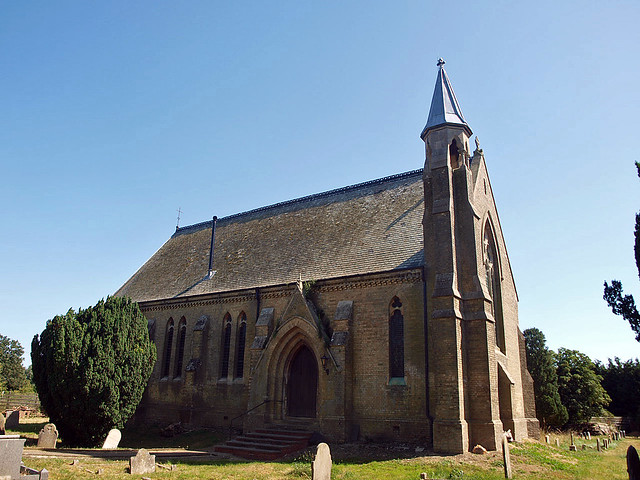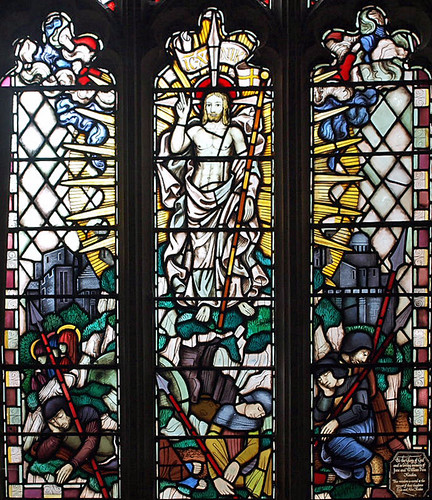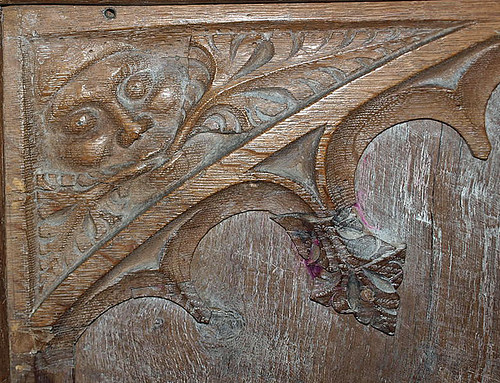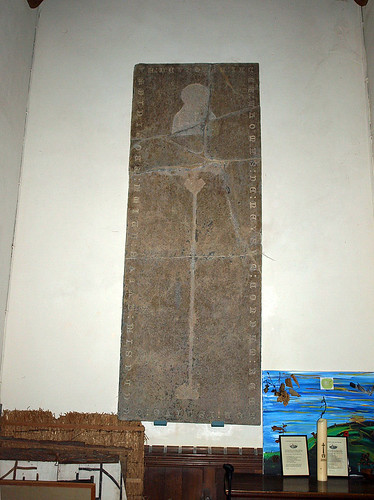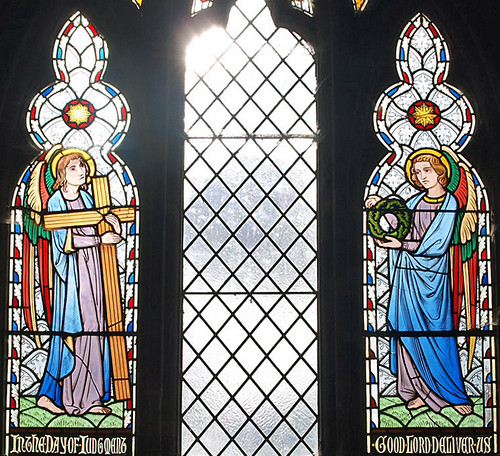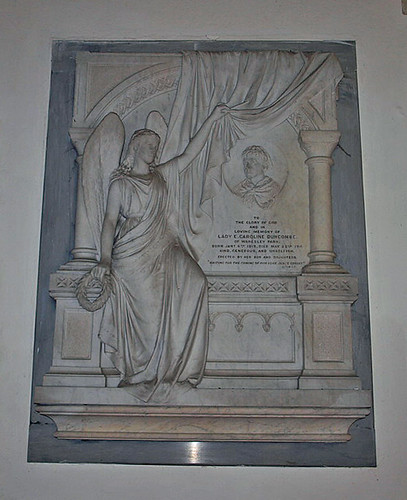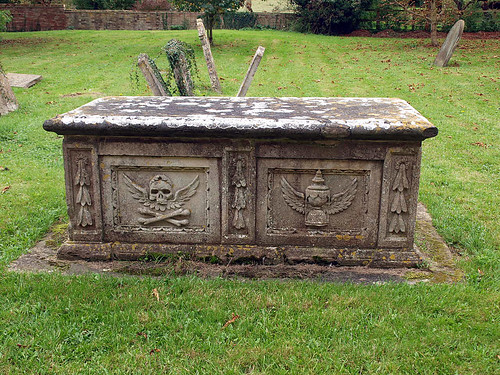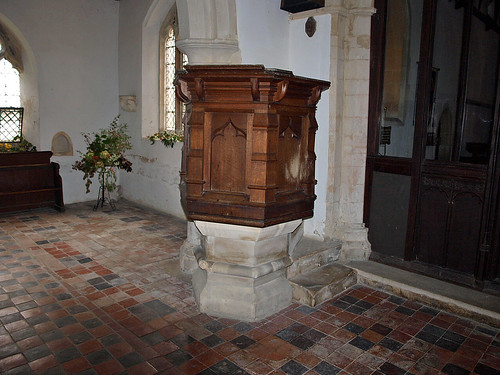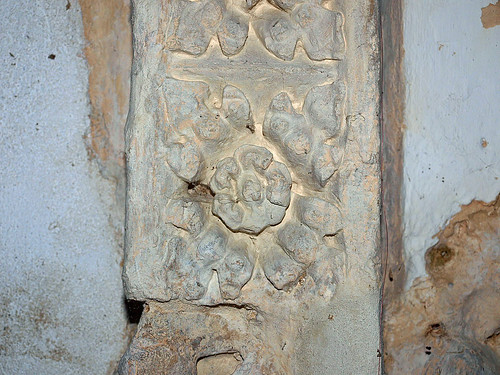St Mary the Virgin, open, is huge and magnificent and is, probably rightly, referred to as the cathedral of Huntingdonshire. It plays host to some very fine Hardman and Clayton & Bell glass and in the chancel is the extraordinary Rowley monument.
ST MARY. One of the largest, most uniform late medieval churches in the county. Apart from one early C13 lancet window in the N wall of the chancel, better visible from the vestry, all is Perp. The body of the church was apparently complete by 1486, the porches were added in 1489, and the W tower begun at about the same time. Wills refer to work on the top pinnacles in 1526-35. The tower is the most impressive element of the church, 130 ft high and broad, with uncommonly high and substantial pinnacles. There are intermediate pinnacles on merlons as well, decorated with the signs of the Evangelists. The parapet has faces and paterae. The buttresses are of the set-back type and have gablets applied to them. They end in their own pinnacles, detached from the body of the tower - a Somerset trait. Doorway with tracery spandrels and little double-X motifs in one moulding. They repeat in the moulding of the broad middle mullion of the large four-light W window which has a castellated transom. Large blank three-light N and S windows. The bell-stage has pairs of two-light openings, again with a castellated transom. There are decorative friezes as well at base, top, and in between. It is all entirely of a piece and done without faltering. The rest of the church is embattled. All the windows are large, the buttresses have gablets, the S porch is two-storeyed with pairs of windows to the E and W, and the S doorway has traceried spandrels. The N porch is similar but a C19 rebuilding, with much original material re-used. Both it and the N doorway have traceried spandrels. Three-light clerestory windows. Short chancel. The arch from the tower to the nave is extremely high. The nave is separated from the aisles by high five-bay arches with piers of the standard moulded section. The arches still have the two sunk quadrants of the Dec style. At the E end of the S arcade an arch starts into the chancel arch. How did that come about ? It is probably the one-bay S chapel which interferes. To the N its W arch dies into the impost, to the S there is a respond, so it may be that the chapel was there earlier and a plan existed to do away with it. However, if so, it was given up; for the arch to the chancel is Perp like the arcades, and also like the corresponding and the W arch of the N chapel. Original, exceptionally ornately decorated roofs in the nave, the N and S aisles, and both chapels. They have crested cornices and ornaments, plenty of angels with shields, and in addition in all sorts of places angels, monsters, a mermaid, camels, dogs, lions, fishes, an eagle, an elephant, fox and goose, hare and hound, and so on. Pretty niche with a nodding ogee arch in the N wall. - PULPIT of 1846-8. - STALLS of 1860, but a few of the C15 or early C16 from Milton Ernest. Carved arms, misericords with shields and inscriptions. - COMMUNION RAIL. C18, of wrought iron. - SCREENS. Several Perp screens, the most attractive the W screen of the N chapel, with lovely transparent vine scrolls over the entrance. - The others have broad ogee-arched one-light divisions. - In the N aisle moreover a few fragments from painted panels of a screen dado. - STAINED GLASS. Much by Clayton & Bell (e.g. tower W c.1868-70) and by Hardman (e.g. Woman of Samaria, S aisle, exhibited at the Paris Exhibition in 1878). Also by Clayton & Bell the Transfiguration, also by Hardman the Widow of Nain. - PLATE. Set of 1754-5. - MONUMENT. The monument to G. W. Rowley and his wife is a fabulous piece of display. The recumbent effigy of Mrs Rowley d 1886 by Thomas Earp is hardly visible behind a grille of the closest, most ornate decoration, and the canopy rises, with statuary and canopies and pinnacles, to the roof. It was designed by Frederick A. Walters and put up in 1893. - (In the N chapel on the floor a defaced C13 slab with a foliated cross supported by a dog; cf. e.g. Pavenham, Beds.)
CONGREGATIONAL CHURCH, High Street. 1887-8 by Edward J. Paine (GS). Red brick with a W steeple. Perp. (Original fittings.)
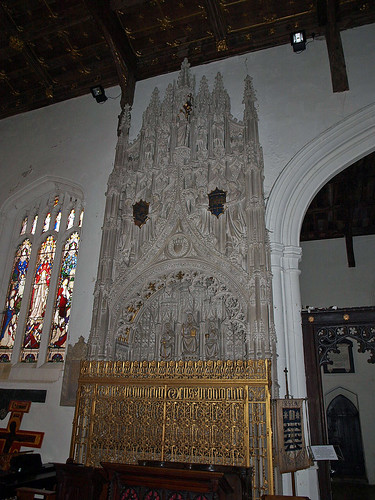
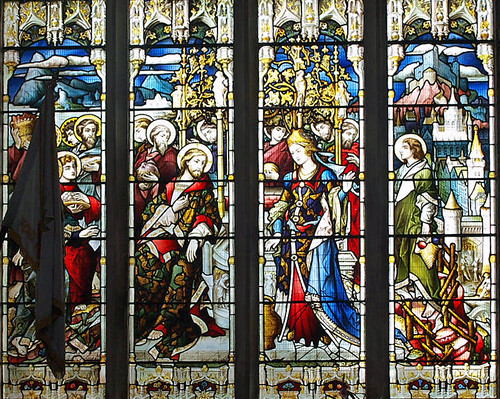
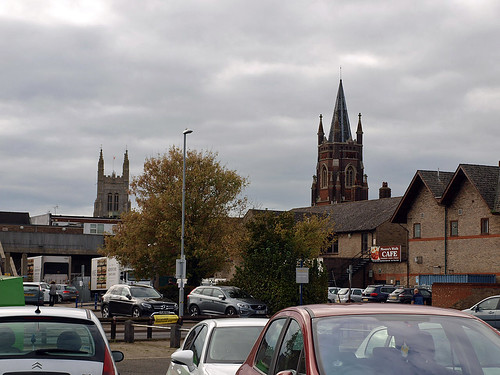
ST NEOTS. Its fine stone bridge, with some of the stones the 14th century men put there but with 17th century walls, leads out of Bedfordshire into the most spacious marketplace in Huntingdon, one of the biggest in England. At one end is what is often called the Cathedral of Huntingdonshire as a tribute to its elegant and symmetrical design and its magnificent roofs.
They have in them a crowded medieval zoo, for the 15th century craftsmen gave their patron saint some of the best of their carving. He is supposed to be the man on the famous jewel King Alfred used to wear, now in the Ashmolean Museum at Oxford, and he has two remarkable tributes paid to him by medieval artists in the two towns named after him; they are the wonderful windows at St Neots in Cornwall and the wonderful roofs at St Neots in Huntingdon. It is believed that St Neot was a brother or kinsman of Alfred, and that when the Danes invaded the eastern part of England he with Alfred was driven to flee to the west, where he founded the priory of St Neot in Cornwall.
Angels with crosses, books, and chalices hold up the great beams, while the smaller beams are carved with angels, beasts, and birds. Some of the angels have musical instruments; we noticed the bagpipe and the lute. A regular procession of animals runs round the cornice among the foliage of the vine; there are lions and eagles and wyverns, camels and griffins, dogs and hares, harts and rams.
The roofs are low-pitched and have open tracery work resting on the beams, and everywhere in the two chapels and the two aisles, -as in the nave and chancel, is the same richness of carving, with saints and angels, beasts and monsters, with something here like an elephant and something there like a unicorn, and at the feet of the beams always angels with crowns or books or scrolls. It is one of the most astonishing collections of wood-carving we have seen. The chancel roof has saints and apostles on the wall-posts and 96 panels painted with hundreds of gold stars.
The eye is drawn as we enter by the glow of colour from over 20 windows, but the spacious pageantry does not stand the artist’s test. The windows .have about 450 figures in them, and one or two of the groups are attractive, such as the window in which the fishermen are drawing in a net full of fishes, with Christ looking on; that in which Simeon is receiving the Child in the temple, with the Madonna kneeling; and the two windows showing feasts, with spectators looking down from the galleries. The windows are all modern, and the only old glass in the church is in the small room over the porch. We reach this room by a nail-studded door with strap hinges and a wooden lock. The room has an old library of about a hundred books, some 16th century, and a chest which was stolen one day in that year of revolution 1848 and was found the next day in a brook. The walls of this little room have traces of painting, and in the windows St Lawrence with his gridiron and St Stephen with stones are painted on old glass. There is another fragment of old glass with an angel in blue in the south aisle tracery.
On one of the aisle walls is an elegant canopied niche resting on a charming bracket with vine ornament; it is 500 years old and has dainty tracery, spandrels carved with oak leaves and acorns, and a vaulted ceiling. Much older, looking rather Saxon yet supposed to be 13th century, is the colossal font which was once the top of a column in an earlier church. On another wall is a lovely little fragment of carving begging us to pray for the soul of Saint Neot, whom some imagine to have been buried here, though we believe him to lie in the Cornish St Neots.
Behind a gilded iron screen in the chancel, wrought into Tudor roses along the top, is the alabaster figure of a lady well remembered here last century: she is Mrs Rowley, and she has a huge canopied tomb with angels climbing to the roof. Facing the tomb are three 15th century misereres, probably made by the man who carved the beautiful tracery of the old oak screen. There are two other misereres in the sanctuary and facing them is a fine altar table 300 years old, lightly carved with faces. The table has been away and has figured in the courts; the story we are told is that it was given by a vicar to another church, which declined to part with it until £1000 had been spent in getting it back.
Herons are seen flying over St Neots, there being a heronry with about ten nests at Ford House. Priory Hill, the home of the lord of the manor, is reached through a fine avenue of elms. There are many 17th and 18th century houses and splendid views of the river, but we find ourselves drawn most of all along the narrow trackway that leads to fields in which we found a deep moat filled with water. We crossed the moat and found ourselves on six acres of a farm round a house known as Monks Hardwick, a fragment of Elizabethan England which was the home of Cromwell’s cousin Henry. But long before his day it was the home of a company of monks.
A minute’s walk among the great oaks in the field brought us to a thrilling place, for we were walking in the trenches of the Civil War. It is said that the Royalists shut up in the church would amuse themselves by firing at the roof of the nave, and certainly they had abundant targets for their bullets. Here Cromwell must have been; here were fired some of those shots that shook a throne and established our English freedom for all time.
Perhaps we should remember here that St Neots has a new claim to fame in our time, for it is the birthplace of the four Miles children, affectionately known as the Quads, whose welfare has naturally enough become a national interest.
The Cradle of a Revolution in Fleet Street
LITTLE do people dream of the part the paper mill at St Neots has played in the modern development of the world. It is known throughout the paper trade as Mill Number 24, but it was sad, at the end of so long a history, to find the mill fallen upon bad times.
Even when the Conqueror’s Domesday Book was being compiled in 1086 there was a water mill on this site, and we find the mill mentioned in medieval days as grinding corn for the monks of St Neots. When the Priory was dissolved by the King in 1539 the mill passed into possession of the Cromwells, and from 1631 to 1800 it remained with the Sandwich family. For 700 years it was used for grinding corn and at last was rebuilt in 1799 and leased for paper-making by Henry Fourdrinier, who set up here the first satisfactory paper-machine ever built. It was in the year after Trafalgar, when this Frenchman had for some time been experimenting with the clever engineer Bryan Donkin in mills at Dartford.
Till the close of the 18th century every sheet of paper was made entirely by hand, a laborious process involving moulds. In 1798 a Frenchman named Louis Robert invented a machine with a continuous wire web on which the pulp could be run into as long a band as required.
Fourdrinier had learnt the trade in his father’s business in Lombard Street, London, and at 35 he took out his first patent. Years of experiment and failure followed, and it was only in 1807 that paper came freely from the machine in the St Neots mill. Though Parliament extended the patent for 14 years, the law was so bad that when Fourdrinier was not spending money on his machine he was fighting for his rights. After having spent £60,000 he became bankrupt.
What he had to contend with we may imagine from the story of his treatment by the Tsar. When Tsar Alexander was in England in 1814 he went to see the new machine at work. He was one of the few progressive rulers of Russia, and ordered two machines. Fourdrinier sent his son to erect them at Peterhoff under an arrangement that for ten years the Tsar should pay £700 a year for them. Nothing was paid, and after many years Henry, when 72 years old, went to Russia with his daughter to hand his petition to Tsar Nicholas. His petition was ignored and the old man seemed doomed to poverty; but so great was the benefit he had conferred on his generation that he was voted a sum of £700 by Parliament, and for the last 14 years of his life was able to live quietly, reading each morning the big newspapers which the industry of his earlier years had made possible.
So it may be said that St Neots was the cradle of the invention on which the character of the modern newspaper is based, the continuous roll of paper (the five-mile roll which everybody sees today in the streets) which is put on one end of a printing machine and comes out at the other complete for the breakfast table, instinct with good or ill for mankind.
